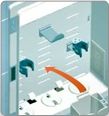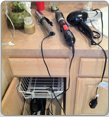Safety and Convenience
According to the US Consumer Product Safety Commission, in an average year children less than 5 years of age suffer approximately 7,700 burn injuries which require hospital emergency room treatment when they touched hot curling irons. In addition, the CPSC estimates that each year, about 4,000 injuries associated with electric extension cords are treated in hospital emergency rooms. About half the injuries involve fractures, lacerations, contusions, or sprains from people tripping over extension cords. Thirteen percent of the injuries involve children under-five years of age.
The CPSC has investigated a number of injuries that illustrate the major accident patterns associated with extension cords, namely children putting extension cords in their mouths, overloaded cords, worn or damaged cords, and tripping over cords.
A study conducted by the Division of Emergency and Trauma Services, Department of Pediatrics, Children’s Hospital Medical Center of Akron, OH describes curling iron-related injuries reported to the National Electronic Injury Surveillance System (NEISS) between January 1, 1992, and December 31, 1996. The findings were as follows: there were an estimated 105,081 hair care product-related injuries in the five-year period, of which 82,151 (78%) involved a curling iron. Seventy percent of injuries were to females. Most curling irons use small amounts of power, yet there are no standards for temperature settings or control.
The ability to put hot appliances away, out of the reach of children and to maintain a well-organized space free of potentially dangerous cords, is nothing short of revolutionary. And makes the Hair Care Hideaway a product any consumer can feel good about buying.
SOURCE: US Consumer Product Safety Commission – March 2001
U.S. Consumer Product Safety Commission – April 17, 2007
Acad Emerg Med. Study, Children’s Hospital 2001
According to the National Council on Patient Information and Education, medications should be kept in a cool, dry area since heat and humidity can be damaging. For this reason, medications should not be stored in a medicine cabinet in the bathroom.
Kimberly D. Padgett, PharmD Candidate at Florida A&M University College of Pharmacy & Pharmaceutical Sciences, states, “Proper storage of medications is one of the many things we learn on the way to becoming pharmacists and I agree that medications should not be stored in a bathroom due to the damaging effects of heat and moisture.”
Reference:
“Tips on Safe Storage and Disposal of Your Prescription Medicines.” National Council on Patient Information and Education. 2008. Accessed April 21, 2012. http://www.talkaboutrx.org/documents/safe_storage.pdf




